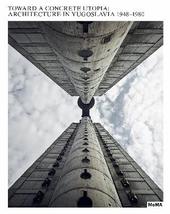
|
Toward a Concrete Utopia: Architecture in Yugoslavia, 1948-1980
Hardback
Main Details
Description
Published in conjunction with a major survey exhibition on the architectural production of Yugoslavia between 1948 and 1980, this is the first scholarly publication to showcase an understudied but important and exceptional body of modernist architecture. Squeezed between the two rival Cold War blocs, Yugoslav architecture consistently adhered to a modernist trajectory. As a founding nation of the Non-Aligned Movement, Yugoslavia became a major exporter of modernist architecture to Africa and the Middle East in a postcolonial world. By merging a variety of local traditions and contemporary international influences in the context of a unique Yugoslav brand of socialism, often described as the 'Third Way', local architects produced a veritable 'parallel universe' of modern architecture during the forty-five years of the country's existence. This remarkable body of work has sparked recurrent international interest, yet a rigorous interpretative study never materialized in the United States until now. Published in conjunction with a major exhibition on the architectural production of Yugoslavia between 1948 and 1980, this is the first scholarly publication to showcase an understudied but important body of modernist architecture. Featuring new scholarship and previously unpublished archival materials, this richly illustrated publication sheds light on key ideological concepts of Yugoslav architecture, urbanism, and society by delving into the exceptional projects and key figures of the era.
ReviewsA manifestation of radical diversity, hybridity, and idealism that characterized the Yugoslav state iself.-- "Blouin Art Info" Above all, the exhibition reminds us that design can be a tool of social progress.--Justin McGuirk "New Yorker" Abundance of beautifully hung and arranged drawings, photographs, and models of striking, and in some cases downright bizarre, buildings and monuments.--Josephine Minutillo "Architectural Record" Astonishing structures surge with unchecked emotions of agony, sacrifice, loss and rememberance.--Julie V. Iovine "Wall Street Journal" Documents how buildings and the architects behind them contribute to the modernization and social cohering of a historically multiethnic region.--Theodossis Issaias "Metropolis" From housing blocks to a rural mosque, ponder marker of unity and individualism from a now-vanished postwar building culture.-- "Art Newspaper" Highlighting a significant yet thus-far understudied body of modernist architecture, whose forward-thinking contributions still resonate today.-- "The Architects Newspaper" Highlights architecture's role in creating a common history and collective identity of a socialist state.--Sofia Lekka Angelopoulou "Designboom" Tells one of the most underappreciated stories of postwar architecture: the rise of avant-garde government buildings, pie-in-the-sky apartment blocks, mod beachfront resorts and even whole new cities in the southeast corner of Europe.--Jason Farago "New York Times" The great achievement of Yugoslavia was in being able to keep collectivism and individualism in some kind of balance.--Justin McGuirk "The New Yorker" These otherwordly constructions were instrumental in shaping Yugoslavia's national identity.--Joanna Fu "Hypebeast" This exceptionally designed show succeeds in distilling the architectural legacy of a country best known, in and outside of it, for falling apart.--Roko Rumora "Hyperallergic" What struck me most about this long-overdue examination was that, despite economic limita-tions and the dominance of Communist Bloc aesthetics, extraordinary creativity and diversity persisted-attributes that feel in conspicuously short supply even within today's increasingly privatized milieu.-- "Artforum" Yugoslavia's unique position anticipated the current age of globalism, and studying its architecture will tell us more about postwar modernity than the tired old histories do.-- "PIN-UP"
|